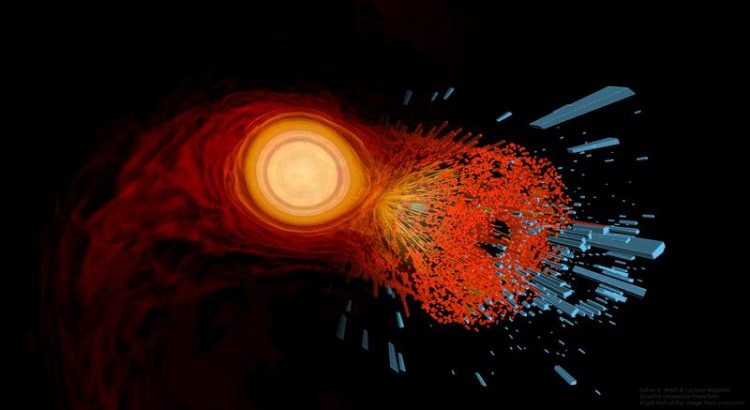Gravitational waves could prove the existence of the quark-gluon plasma

Montage of the computer simulation of two merging neutron stars that blends over with an image from heavy-ion collisions to highlight the connection of astrophysics with nuclear physics. Lukas R. Weih & Luciano Rezzolla (Goethe University Frankfurt) (right half of the image from cms.cern)
According to modern particle physics, matter produced when neutron stars merge is so dense that it could exist in a state of dissolved elementary particles. This state of matter, called quark-gluon plasma, might produce a specific signature in gravitational waves.
Physicists at Goethe University Frankfurt and the Frankfurt Institute for Advanced Studies have now calculated this process using supercomputers. (Physical Review Letters, DOI 10.1103/PhysRevLett.124.171103)
Neutron stars are among the densest objects in the universe. If our Sun, with its radius of 700,000 kilometres were a neutron star, its mass would be condensed into an almost perfect sphere with a radius of around 12 kilometres.
When two neutron stars collide and merge into a hyper-massive neutron star, the matter in the core of the new object becomes incredibly hot and dense. According to physical calculations, these conditions could result in hadrons such as neutrons and protons, which are the particles normally found in our daily experience, dissolving into their components of quarks and gluons and thus producing a quark-gluon plasma.
In 2017 it was discovered for the first time that merging neutron stars send out a gravitational wave signal that can be detected on Earth. The signal not only provides information on the nature of gravity, but also on the behaviour of matter under extreme conditions. When these gravitational waves were first discovered in 2017, however, they were not recorded beyond the merging point.
This is where the work of the Frankfurt physicists begins. They simulated merging neutron stars and the product of the merger to explore the conditions under which a transition from hadrons to a quark-gluon plasma would take place and how this would affect the corresponding gravitational wave. The result: in a specific, late phase of the life of the merged object a phase transition to the quark-gluon plasma took place and left a clear and characteristic signature on the gravitational-wave signal.
Professor Luciano Rezzolla from Goethe University is convinced: “Compared to previous simulations, we have discovered a new signature in the gravitational waves that is significantly clearer to detect. If this signature occurs in the gravitational waves that we will receive from future neutron-star mergers, we would have a clear evidence for the creation of quark-gluon plasma in the present universe.”
Publication: Post-merger gravitational wave signatures of phase transitions in binary mergers
Lukas R. Weih, Matthias Hanauske, Luciano Rezzolla, Physical Review Letters Physical Review Letters DOI 10.1103/PhysRevLett.124.171103 https://journals.aps.org/prl/
Video: Visualisation of merging neutron stars: https://www.youtube.com/watch?v=rj-r-YA9d6E&t=1s
This simulation shows the density of the ordinary matter (mostly neutrons) in red-yellow. Shortly after the two stars merge the extremely dense centre turns green, depicting the formation of the quark-gluon plasma.
Pictures may be downloaded here: http://www.uni-frankfurt.de/87973606
Caption Montage: Montage of the computer simulation of two merging neutron stars that blends over with an image from heavy-ion collisions to highlight the connection of astrophysics with nuclear physics. Credit: Lukas R. Weih & Luciano Rezzolla (Goethe University Frankfurt) (right half of the image from cms.cern)
Caption Simulation: Shortly after two neutron stars merge a quark gluon plasma forms in the centre of the new object. Red yellow: ordinary matter, mostly neutrons. Credit: Lukas R. Weih & Luciano Rezzolla (Goethe University Frankfurt)
Further information:
Goethe University Frankfurt
Prof. Dr. Luciano Rezzolla
Chair of Theoretical Astrophysics
Institute for Theoretical Physics
+49-69-79847871/47879
rezzolla@itp.uni-frankfurt.de
https://astro.uni-frankfurt.de/rezzolla/
Current news about science, teaching, and society can be found on GOETHE-UNI online (www.aktuelles.uni-frankfurt.de)
Goethe University is a research-oriented university in the European financial centre Frankfurt am Main. The university was founded in 1914 through private funding, primarily from Jewish sponsors, and has since produced pioneering achievements in the areas of social sciences, sociology and economics, medicine, quantum physics, brain research, and labour law. It gained a unique level of autonomy on 1 January 2008 by returning to its historic roots as a “foundation university”. Today, it is one of the three largest universities in Germany. Together with the Technical University of Darmstadt and the University of Mainz, it is a partner in the inter-state strategic Rhine-Main University Alliance. Internet: www.uni-frankfurt.de
Publisher: The President of Goethe University Editor: Dr. Markus Bernards, Science Editor, PR & Communication Department, Theodor-W.-Adorno-Platz 1, 60323 Frankfurt am Main, Tel: -49 (0) 69 798-12498, Fax: +49 (0) 69 798-763 12531, bernards@em.uni-frankfurt.de.
Goethe University Frankfurt
Prof. Dr. Luciano Rezzolla
Chair of Theoretical Astrophysics
Institute for Theoretical Physics
+49-69-79847871/47879
rezzolla@itp.uni-frankfurt.de
https://astro.uni-frankfurt.de/rezzolla/
Post-merger gravitational wave signatures of phase transitions in binary mergers
Lukas R. Weih, Matthias Hanauske, Luciano Rezzolla, Physical Review Letters Physical Review Letters DOI 10.1103/PhysRevLett.124.171103 https://journals.aps.org/prl/
Media Contact
More Information:
http://www.uni-frankfurt.deAll latest news from the category: Physics and Astronomy
This area deals with the fundamental laws and building blocks of nature and how they interact, the properties and the behavior of matter, and research into space and time and their structures.
innovations-report provides in-depth reports and articles on subjects such as astrophysics, laser technologies, nuclear, quantum, particle and solid-state physics, nanotechnologies, planetary research and findings (Mars, Venus) and developments related to the Hubble Telescope.
Newest articles

How marine worms regenerate lost body parts
The return of cells to a stem cell-like state as the key to regeneration. Many living organisms are able to regenerate damaged or lost tissue, but why some are particularly…

Nano-scale molecular detective
New on-chip device uses exotic light rays in 2D material to detect molecules. Researchers have developed a highly sensitive detector for identifying molecules via their infrared vibrational “fingerprint”. Published in Nature…

Novel CAR T-cell therapy
… demonstrates efficacy and safety in preclinical models of HER2-positive solid tumors. The p95HER2 protein is found expressed in one third of HER2+ tumors, which represent 4% of all tumors….



